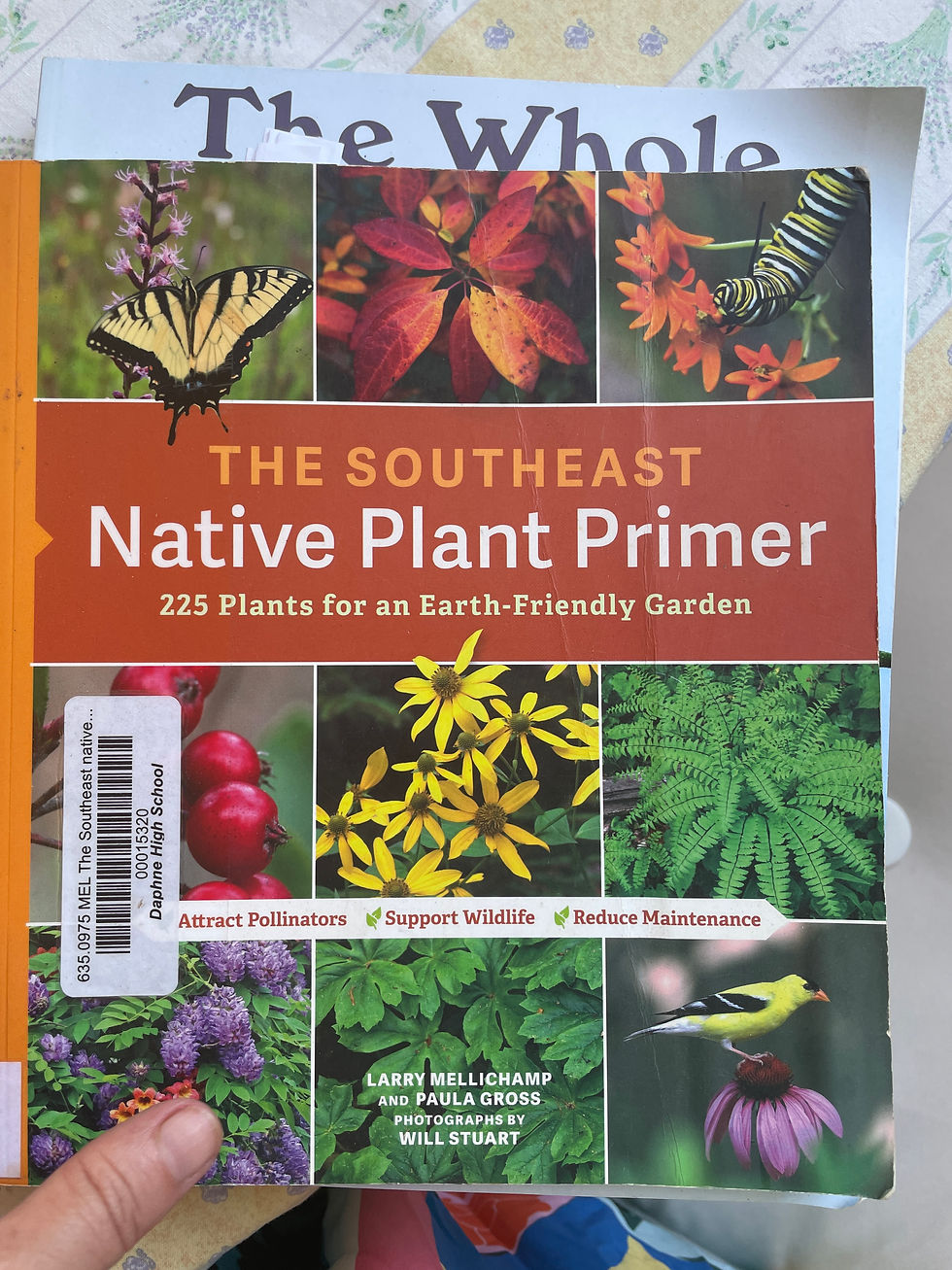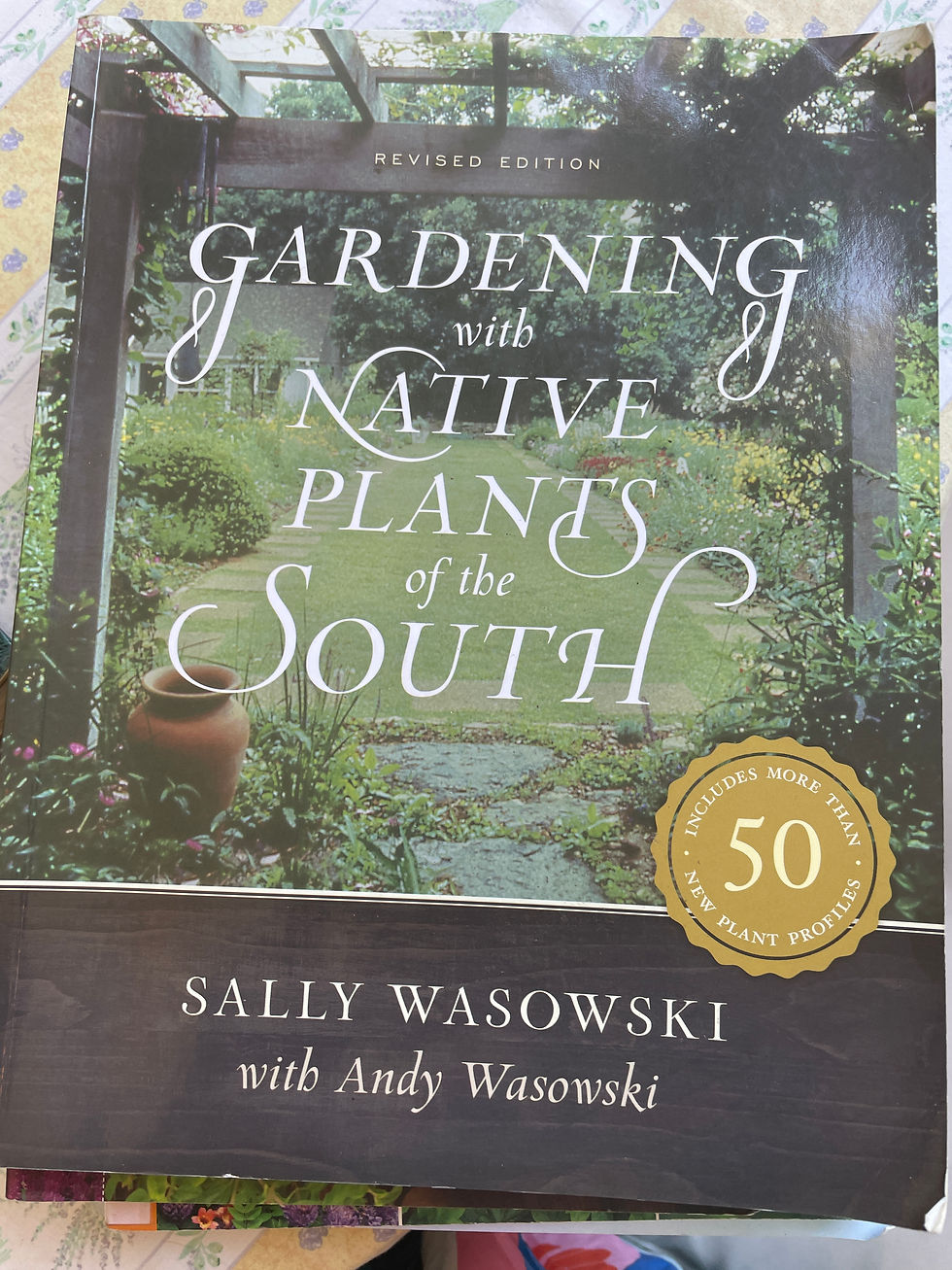Riverbloom Cottage: Landscaping with Native Plants: Beauty, Resilience, and a Thriving Ecosystem
- The Agricoutourist

- Feb 10
- 5 min read
I spent the majority of this weekend cleaning up all of the plants after the extremely cold weather we had a few weeks ago. It was discouraging to say the least. However most of my salvia and other native plants seem to have survived and just needed some cutting back. Learning to landscape with native plants has been a challenge for me but one that has proven to be extremely rewarding. There’s something truly special about stepping into your own yard and feeling like you’re in harmony with nature. From enhancing biodiversity to being more resilient in local climates, native plants offer a range of benefits that go well beyond aesthetics. Here’s why I chose to fill my yard with natives—and why you may want to do the same.

I mix my native perennials in with potted annuals until they get large enough to go into the yard and survive.
1. Embracing the Natural Beauty of Homegrown Flora
One of the first things that attracted me to native plants was their effortless beauty. Unlike many ornamental species that may struggle in our climate or look out of place, native plants thrive in the conditions they’ve evolved to handle—be it drought tolerance, humid summers, or cool winters.
No-Fuss Gardening: Because they’re adapted to local soil types and weather patterns, natives often require less watering, fertilizing, or pampering.
Seasonal Changes: Native plants tend to put on vibrant seasonal displays, from spring blooms to autumn foliage.
In my yard, I’ve chosen coneflowers, milkweed, and black-eyed Susans, butterfly bushes, salvia and dozens more for their bright, cheerful blossoms and ease of care. They bring color and life to my beds and borders without demanding a lot of attention.

A butterfly bush I propagated just last year
2. Environmental Benefits: Helping Our Local Ecosystem
a. Sustainability & Resilience
One of the standout advantages of native plants is how well they adapt to local climate extremes—rain or shine, heat or cold. This built-in resilience translates to:
Lower Water Usage: Reduced watering needs because the plants are used to your region’s natural rainfall amounts.
Fewer Chemicals: Native species are more resistant to local pests and diseases, which often means less reliance on pesticides or herbicides.
b. Habitat & Biodiversity
By choosing plants that have co-evolved with local fauna, you’re creating habitats for everything from insects to small birds. This helps sustain biodiversity right in your own backyard:
Pollinator Haven: Bees, butterflies, and hummingbirds rely on native blossoms for nectar and pollen.
Food & Shelter: Many native grasses and shrubs provide shelter and nesting sites for birds and beneficial insects.
In my neighborhood, I’ve noticed an uptick in friendly critters—especially bees and butterflies—thanks to the wild bergamot and goldenrod I planted around my garden beds.

See the book here: https://amzn.to/4huWyZE
3. Boosting the Neighborhood Bee Population
My neighbors raise bees and so making sure they have plenty of food was a priority when selecting my plants. Bees are crucial pollinators, responsible for fertilizing countless plant species (including many of the fruits and vegetables we eat). But bee populations have faced numerous challenges in recent years. By filling my yard with native wildflowers, I’ve:
Supplied Year-Round Food Sources: Different native plants bloom at various times, providing a constant buffet of pollen and nectar.
Created Safe Zones: Fewer pesticides means a safer haven for bees, which encourages them to stick around.
Neighbors often comment on how the local bee population seems healthier and more active, especially during the peak bloom months. It feels good to know our gardens collectively support these indispensable pollinators.

Getting started on the yard and remodeling an old ranch river house

4. Hummingbird & Butterfly Entertainment
Beyond being environmentally friendly, a native plant landscape is endlessly entertaining. I love sitting on my porch or peeking out the window to watch:
Hummingbirds darting from flower to flower, hovering with incredible precision.
Butterflies dancing among the blossoms, pausing just long enough for me to catch a glimpse of their patterns.
Not only do these moments bring joy, but they also remind me how connected we are to the natural world. Each flower I’ve planted plays a small but meaningful role in sustaining local wildlife—and the wildlife’s presence transforms my yard into a living, breathing work of art.

Attracting Birds And Butterflies (Home Grown Gardening) https://amzn.to/4huWyZE

The Southeast Native Plant Primer: 225 Plants for an Earth-Friendly Garden https://amzn.to/418ezaF
5. Getting Started with Native Landscaping
If you’re considering making the switch to native plants, here are a few pointers:
Research Native Species: Check with local garden centers, native plant societies, or cooperative extension offices for lists of plants well-suited to your region.
Plan for Blooms Year-Round: Choose a mix of species that bloom at different times—spring ephemerals, summer perennials, and fall-blooming shrubs—to keep pollinators happy and your yard colorful.
Consider Microclimates: Even within your yard, different areas may have varying light levels and soil conditions. Match each plant to its preferred growing conditions.
Start Small: If you’re new to native plants, begin with a small bed or border, then expand as you gain confidence.

Gardening with Native Plants of the South https://amzn.to/4hPqD6e

Wild: The Naturalistic Garden https://amzn.to/4hQ9toP

A Step-by-Step Guide to a Florida Native Yard https://amzn.to/3EHPdYb

Southeast Medicinal Plants: Identify, Harvest, and Use 106 Wild Herbs for Health and Wellness https://amzn.to/3CMj5SP
6. Looking Ahead: A Greener Future
Landscaping with native plants is about more than just boosting curb appeal. It’s a step toward a sustainable future—one where homeowners and nature coexist in a mutually beneficial relationship. By reducing our environmental footprint and creating vibrant habitats in our own yards, we can make a big impact on local wildlife, pollinator populations, and community well-being.
Every time I watch bees hovering around my flowerbeds or hummingbirds sipping from a trumpet vine, I feel a renewed sense of hope. Each plant, each bloom, and each pollinator is a little piece of a healthier, more balanced ecosystem. And isn’t that a vision worth cultivating?

Here is a bibliography of my favorite native gardening and design books:
Southeast Medicinal Plants: Identify, Harvest, and Use 106 Wild Herbs for Health and Wellness (Medicinal Plants Series) https://amzn.to/3CGPOsI
Garden Perennials for the Coastal South https://amzn.to/3Ex20wD
Southeast Home Landscaping, 3rd Edition https://amzn.to/3CIyl33
Native Plants of the Southeast: A Comprehensive Guide to the Best 460 Species for the Garden https://amzn.to/40Q71b1
Native Plant Gardening for Birds, Bees & Butterflies: Southeast https://amzn.to/416wsXm
The Southeast Native Plant Primer: 225 Plants for an Earth-Friendly Garden https://amzn.to/3WVVVjH
Gardening with Native Plants of the South https://amzn.to/4guzPfa
Landscaping with Fruit https://amzn.to/4aRK0sU
The Seasonal Gardener: Creative Planting Combinations https://amzn.to/4hASdnV
Prairie Up: An Introduction to Natural Garden Design https://amzn.to/419eF1Q
Floret Farm's Cut Flower Garden https://amzn.to/3Cy9Rtp
Heirloom Gardening in the South: Yesterday's Plants for Today's Gardens https://amzn.to/4k2DQum
Cut Flowers, Foliage and Fruits of the Southeast https://amzn.to/40UY0xB
A Step-by-Step Guide to a Florida Native Yard https://amzn.to/4jTD9TM
Simply Sustainable Landscapes: Designing with Edible and Native Plants for the Southeast https://amzn.to/3QbicGA
Month-by-month Gardening In Alabama https://amzn.to/3Q9VKNN
Final Thoughts
If you live in a neighborhood with and HOA, you may rescieve initial pushback on your landscape design. I have found getting a pollinator friendly garden sign helps your neighbors understand what you are trying to accomplish. https://amzn.to/42PWxel
Transforming your yard with native plants is like setting out a welcome mat for bees, butterflies, hummingbirds, and more—all while benefiting the environment and reducing maintenance demands. It’s a win for you, a win for the neighborhood, and a win for Mother Nature. If you’re thinking of making a change in your landscape, consider going native. You’ll find yourself rewarded with a yard that buzzes, flutters, and thrives in perfect harmony with the world around it.





Comments